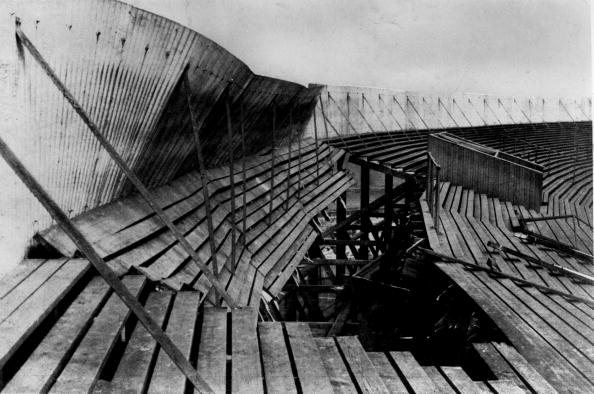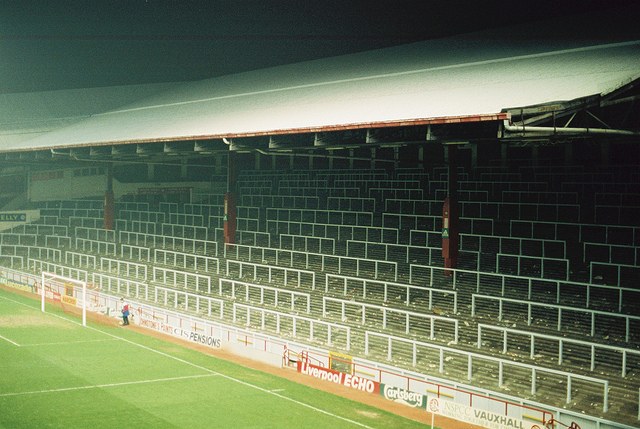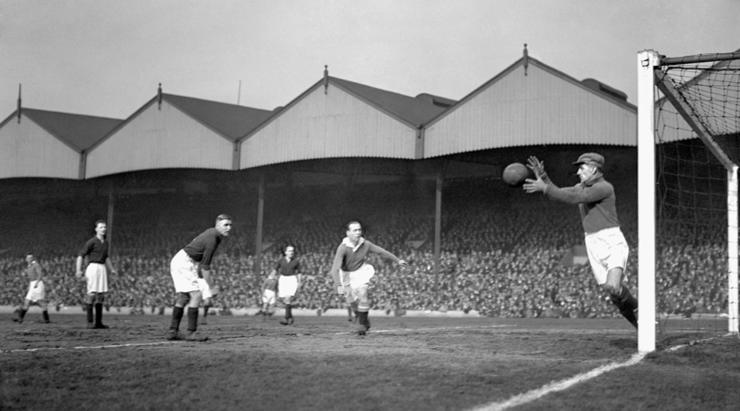The chronicles of Archibald Leitch: Remembering Britain’s legendary football architect

I remember when I first started following the Premier League. It was around a decade ago and the championship was brimming with local and international talent; the likes of Henry, Beckham and Van Nistelrooy all made watching the Premier League a fantastic experience. But then, that’s probably a topic someone’s already written about to their heart’s content. The aim of this article is to bring to light something else that caught my attention during those initial years of Premier League mania and it revolves around – to put it very briefly – the stadiums.
I was always intrigued by the design of those huge intimidating structures that housed tens of thousands of expectant fans every match day. The atmosphere seemed magically unique, even on television screens. I longed to visit a British stadium more than any other stadium in the world. I can’t really put my finger on it but there was something that set the stadiums of Britain apart. A few years ago, when I started off trying to find out more about these stadiums, I noticed that there was a common factor to most of these venues. The more I read through articles, the more I read about a certain name. This name would keep popping up without fail. It was the name of a Scottish architect – Archibald ‘Archie’ Leitch.

Curiously, I browsed and sought more information about Leitch and found out that he had designed part or all of numerous famous stadiums in the British Isles, including Old Trafford, Anfield, Highbury, Stamford Bridge, Villa Park, Craven Cottage, Hampden Park, Ibrox Park, Celtic Park, Twickenham, Lansdowne Road and White Hart Lane. He is therefore probably a person worth reading about for almost all die-hard fans of British football.
Engineering Archie
Simon Inglis, a noted footballing historian, documented the highs and lows of Archie Leitch’s architectural career in the book ‘Engineering Archie: Archibald Leitch – Football Ground Designer.’ Inglis is an admirer of Leitch’s designs and has campaigned for Leitch to be recognised – primarily, to honour his legacy and also because most of Leitch’s works have disappeared as a result of renovation and redevelopment projects. More than 70 years after his death, stadiums designed by Leitch have changed in shape and size, to become completely unrecognisable. Some have been demolished. But part of his influence still remains intact to this day: at Fulham’s Craven Cottage, for instance.

The main stand at the Cottage, known as the Johnny Haynes Stand today and previously as the Stevenage Road Stand, was designed by Leitch in 1905. Its façade is built in Leitch’s own red brick style. The stand is now the oldest football stand in the Football League system and along with the Pavilion, it is the most iconic part of Craven Cottage. But despite the folklore associated with the stand and the stadium as a whole, Fulham moved out of the Cottage and into Queens Park Rangers’ Loftus Road ground in early 2002, in order to meet Premier League requirements. The move was met with uproar from fans, many of who subsequently only attended away games as a form of protest. Eventually, the fans got their way.
After two years of protests and refurbishment that cost £5.4 million, Fulham returned to Craven Cottage. There were new seats and new floodlights, but Archibald Leitch’s legacy remained: the main stand and the Pavilion were untouched. That is undoubtedly an indication of how highly Leitch’s work has been valued by clubs, more than six decades after his death. Craven Cottage remains one of the smallest stadiums in the Premier League but as the fans will attest, it is not the size, but rather the ambience and history that make it so loved – and Archibald Leitch has quite a lot to do with it.
The Ibrox disaster
Leitch’s first notable work, however, was back in his native Glasgow where he designed the Ibrox Park stadium for his boyhood heroes Rangers. His love for Rangers was such that he did his work for free! It was an honour for him to design the home of his favourite team and he duly delivered it in December 1899; it was an oval stadium, with an athletics track, and housed 40,000 people. A couple of years after its opening, disaster struck.

It was the 5th of April, 1902 and Ibrox was slated to host a match between Scotland and England. After the addition of wooden terracing at the western and eastern ends, the capacity was now near 76,000 and Ibrox had become arguably the largest purpose-built football stadium in the world at that time. But prior to the game, there were concerns about the stability of the structure. Those concerns turned into a real nightmare during the game, when part of the terracing collapsed: it took with it more than 100 people who fell 50 feet onto the ground. In the ensuing panic, many other fans collapsed onto each other as they rushed to safety. In all, 25 people were killed and 517 others were injured.
Leitch couldn’t believe it. The Surveyor had deemed the stadium fit to host the match; but reality showed that it wasn’t quite like that. The aftermath of the disaster would give Leitch a hard time. Leitch attempted to put the blame on the contractor, pointing to the poor quality of the timber. While the contractor was named as the accused, almost everyone involved believed that Leitch was partly culpable too. The defence lawyer argued that contractor was being scapegoated and that the case was “as flimsy and insubstantial as Mr. Leitch’s design.” In the end, the contractor was cleared of all charges, while Leitch’s future lay in the balance.
For Leitch, the disaster was the darkest point of his career and when we look at what transpired in the many years after it, it was a make-or-break moment. His future prospects all came down to his relationship with Rangers. There was a genuine cause for concern for his reputation and his career. But surprising as it may sound, Rangers decided to continue with Leitch. Nobody knows why exactly they did so, but as Inglis argues, there was something in Archie Leitch’s ability that Rangers just couldn’t fire him.
Revival and the era of terraces
From then on, Leitch went from height to height. Rangers’ support for him after the Ibrox disaster surely helped protect his career. Another man would have collapsed under the strain, and walked away from stadium design in defeat. But not Leitch; he wouldn’t throw in the towel. He started work on making stadium terraces safer. In the pursuit of a safer and better terrace, Leitch would go on to revolutionise the design of terraces in stadiums all over the country. His designs set the standard and would still be followed decades after his death. For a large part of the 20th century, the terrace would be an inseparable part of British football culture. Inglis places the credit for it firmly on the shoulders of Leitch by calling him ‘the man who designed the modern football terrace.’ Leitch’s terraces had fixed steps, designated aisles and his own patented steel crush barriers. Terraces were now stronger, safer and better suited for viewing the match.

By the time of his death in 1939, Leitch had become Britain’s foremost football architect. Inglis points to two facts that show how influential Leitch had become. He says: “If you look at the First Division table in 1927, of 22 clubs, 16 had been, at one time or another, clients of Archie. Or think of the 1966 World Cup. Of eight venues used, six were grounds where Leitch had played a significant role. That is some legacy for an unknown engineer.”
The legacy
Leitch-designed stadiums also saw the European Cup winning teams of Celtic, Manchester United, Liverpool and Aston Villa play their way to continental glory. Celtic Park, Old Trafford, Anfield and Villa Park had all become storied names outside Britain. Long before the words ‘European nights’ became a part of footballing vocabularies, these venues provided fans with the opportunity to watch the best of Europe in action. And adding to the great atmosphere was the terraces, particularly in Anfield, where the Kop is still legendary.
There were so many good things to say about Leitch’s terraces but even they had their limitations. Overcrowding was not something that terraces were designed to handle easily. However, as many experts have conceded, efficient management could have done that. It could be argued that the good still outnumbered the bad. But then, all good things must come to an end. If one disaster in April 1902 led Leitch to spark his terrace revolution, another disaster in April 1989 would bring it all to an end. The Hillsborough stadium saw one of the worst tragedies in football history as 96 fans were crushed to death at an FA Cup semi-final. The official inquiry, known as the Taylor Report would blame police and bad crowd management. But it would also sound the death knell for terraces.
The Taylor Report led to new regulations that banned terraces at top division stadiums. Clubs had to convert terraces to all-seater stands while others built new all-seater stadiums. It must be noted that although the Taylor Report stated that terraces weren’t intrinsically unsafe, the authorities decided to ban them nonetheless. Sadly, as Inglis writes in his book, ‘the great irony of the British football terrace was that just as, in the aftermath of Hillsborough, experts finally came to agree on how best to design and manage them, they were abolished.

Thus the famous terraces – Liverpool’s Kop, Manchester United’s Stretford End and Aston Villa’s Holte End gave way to seats. Many of Leitch’s other works disappeared as commercial and safety requirements pushed clubs to renovate and rebuild. The awe-inspiring Trinity Stand at Villa Park, long considered as Leitch’s masterpiece no longer exists.
However there are places where Leitch and his legacy still matter. His cherished heroes Rangers have retained the magnificent red brick façade of Ibrox, throughout all the renovations that the stadium has seen. Others may have built over or demolished his designs but Archibald Leitch’s touches still live on, in and around many of Britain’s famous grounds, unseen and invisible.
”I couldn’t find a single obituary for Archie when he died in 1939, so decided to write his biography to make up for that lack of recognition. Even then, I hardly imagined it would turn out to be such an interesting tale.’ – Simon Inglis
(The writer is a Doha based football writer and an alumnus of the University of Hyderabad. This article which was originally published in sportskeeda is reproduced with his special permission. He can be reached at twitter.com/AhmedH_93)
Discover more from
Subscribe to get the latest posts sent to your email.
